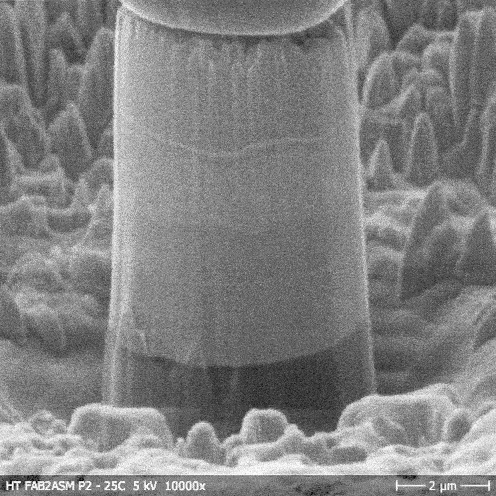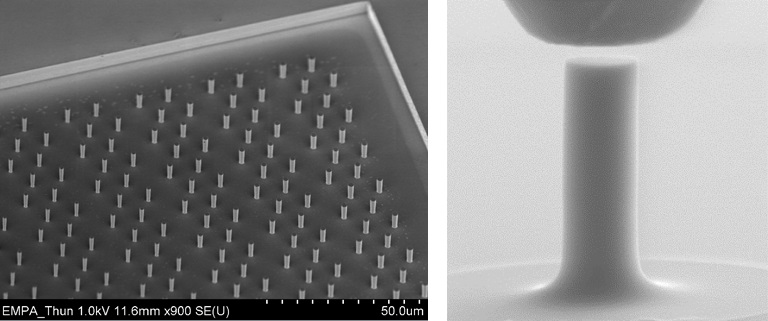A supplementary (and in some instances, replacement) indentation testing technique known as micropillar compression testing has emerged in recent years. Micropillar compression testing is comparable to nanoindentation regarding its ability to precisely quantify various mechanical properties of materials on the microscale, and as such is a vital method for researchers whose primary focus is myriad diverse sample types.
These two techniques are similar in terms of their underlying principles: indeed, this is true to the extent that, to carry out both nanoindentation and micropillar compression tests, almost-identical instrumentation can be used.
This has been proven in conjunction with materials as varied as polymeric fibers, metallic alloys, and refractory ceramics. However, the chief benefit of using micropillar compression instead of conventional nanoindentation, is that the flat punch indenter retains a constant area of contact throughout the duration of the experiment. This means that errors in area function are therefore removed from the calculation of mechanical properties.

Example of a micropillar compression test on a micropillar built from a multilayer stack of different coatings. Image Credit: Alemnis AG
Outlining Micropillar Compression Testing
In the process of a standard micro-compression test, a micrometer-scale (μm) pillar of sample material is compacted in a nanoindenter with a calibrated flat punch probe, instead of compressed by a tip with a pyramidal geometry. It is advisable to perform in situ positioning of the probe tip within the chamber of a scanning electron microscope (SEM), given the extremely small dimensions of the micropillar. To take this precautionary step, therefore, removes the risk of errors associated with poor tip-optic calibration in ex situ testing conditions. However, it is important to note that it is not always appropriate to use an SEM chamber to measure the deformation characteristics of materials. Indeed, there are some materials, for instance, specific polymers, which have a potential for beam damage and cracking in the vacuum conditions of an SEM, and therefore cannot be tested. In such instances, Micropillar compression tests can be conducted under an optical microscope in air.
Accurate insights into the real-world stress-strain properties of materials can be provided by each of these test methodologies, such as extremely complex behaviors, including microscale spatial variation of fracture toughness and elastic moduli. However, it is necessary to extract micropillars from the bulk material before these tests can be conducted.
Micropillar Fabrication
Focused ion beam milling (FIB) is the main method that is used to produce micropillars from bulk materials. FIB is a technology which mirrors the apparatus of a standard SEM array. FIB setups, in contrast to a focused beam of electrons, use instead a high-energy gallium (Ga) ion beam. This Ga ion beam is utilized to sputter the uppermost atomic layers of a material and allow for ultra-precise sample machining, on the sub-microscale. In recent years, this process has gained in popularity thanks to its qualities and reputation for unparalleled accuracy in semiconductor etching applications.
A side-effect of FIB milling which could threaten the measurement accuracies of micropillar compression tests is surface damage and implantation. During processing, it may be required to ramp down the ion current, to optimize the structural and surface finish properties of the micropillar, despite the fact that gallium ion sources at high ion currents are prized for their superior top-down material removal rates. This decreases the likelihood of FIB-induced damage and subsequently inaccurate results, and improves the yield of microscale samples with mechanical properties representative of the bulk material.
A drawback of this process of FIB milling is that in some materials, the micropillar may not have the same diameter over the whole of its length. There is an alternative method, which involves the fabrication of micropillars from lithographic techniques, wherein material is etched away after the process of creating a surface mask. Lithographic techniques hold a key advantage, in that in a few simple stages large arrays of micropillars can be fabricated – and created at a much greater speed than by FIB milling. The pillars produced by such a method may also be more uniform in shape and size. Certain casting techniques are another available option for the production of micropillars, but these techniques are based on the materials deposited, as opposed to the bulk.

Examples of Si micropillar arrays (left) made by lithography and a single micropillar (right) just before contact with a diamond flat punch indenter. Image Credit: Alemnis AG
Micropillar Testing with Alemnis
The development of value-added tools and solutions for advanced application and materials testing studies is a specialty of Alemnis. Their product portfolio is extremely versatile, and includes the industry-leading Alemnis Standard Assembly (ASA). This is a flexible and compact nanoindenter which is ideally suited for nanoindentation testing and micropillar compression experiments. More specifically, the unique displacement control of the ASA makes it the instrument of choice for testing micropillars.

This information has been sourced, reviewed and adapted from materials provided by Alemnis AG.
For more information on this source, please visit Alemnis AG.